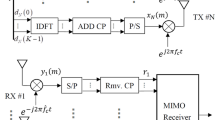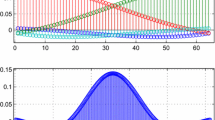Abstract
In this paper, we address the problem of carrier frequency offset (CFO) estimation for orthogonal frequency division multiplexing (OFDM) systems with multi-antenna receiver. The received signal can be reconstructed to form data model with multi-invariance property, and then a multi-invariance MUSIC algorithm for CFO estimation is proposed. This algorithm has better performance of CFO estimation than ESPRIT method, multi-invariance ESPRIT method and trilinear decomposition algorithm, and also qualifies the estimation for both integer CFO and fractional CFO. Simulation results illustrate validity of this algorithm.
Similar content being viewed by others
References
ETSI. (2001). Digital video broadcasting (DVB); framing structure, channel coding and modulation for digital terrestrial television, Standard ETSI EN 300 744, v1.4.1.
ETSI. (2001). Radio broadcasting systems; digital audio broadcasting (DAB) to mobile, portable and fixed receivers, Standard ETSI EN 300 401, v1.3.3.
Moose P. H. (1994) A technique for orthogonal frequency division multiplexing frequency offset correction. IEEE Transactions on Communications 42(10): 2908–2914
Mody, A. N., & Stüber, G. L. (2001). Synchronization for MIMO OFDM systems. In Proceedings of GLOBECOM (Vol. 1, pp. 509–513). San Antonio, TX.
Tureli, U., & Honan, P. J. (2001). Modified high-efficiency carrier estimator for OFDM communications with antenna diversity. In Proceedings of 35th Asilomar conference on signals, systems, and computers (Vol. 2, pp. 1470–1474). Pacific Grove, CA.
Li M., Zhang W. (2003) A novel method of carrier frequency offset estimation for OFDM systems. IEEE Transactions on Consumer Electronics 49(4): 965–972
Minn H., Xing S. (2005) An optimal training signal structure for frequency-offset estimation. IEEE Transactions on Communications 53(2): 343–355
van de Beek J., Sandell M., Borjesson P. O. (1997) ML estimation of time and frequency offset in OFDM systems. IEEE Transactions on Signal Processing 45: 1800–1805
Liu H., Tureli U. (1998) A high-efficiency carrier estimator for OFDM communications. IEEE Communications Letters 2: 104–106
Tureli U., Liu H., Zoltowskl M. D. (2000) OFDM blind carrier offset estimation: ESPRIT. IEEE Transactions on Communications 48: 1459–1461
Yao Y., Giannakis G. B. (2005) Blind carrier frequency offset estimation in SISO, MIMO, and multiuser OFDM systems. IEEE Transactions on Communications 53(1): 173–183
Ghogho M., Swami A. (2002) Blind frequency-offset estimator for OFDM systems transmitting constant-modulus symbols. IEEE Communications Letters 6(8): 343–345
Park B., Cheon H., Ko E. (2004) A blind OFDM synchronization algorithm based on cyclic correlation. IEEE Signal Processing Letters 11(2): 83–85
Tureli U., Honan P. J., Liu H. (2004) Low-complexity nonlinear least squares carrier offset estimator for OFDM: identifiability, diversity and performance. IEEE Transactions on Signal Processing 52(9): 2441–2452
Zheng Z., Huang D. (2007) Robust plateau removed synchronization techniques for multiple-antenna OFDM-based DVB-H receivers. IEEE Transactions on Consumer Electronics 53(4): 1281–1287
Hutter, A., Hammerschmidt, J. S., de Carvalho, E., & Cioffi, J. M. (2000). Receive diversity for mobile OFDM systems. In Proceedings of IEEE WCNC (pp. 707–712).
Kruskal J. B. (1977) Three-way arrays: Rank and uniqueness of trilinear decompositions with application to arithmetic complexity and statistics. Linear Algebra and its Applications 18: 97–138
Swindlehurst A. L., Stoica P., Jansson M. (2001) Exploiting arrays with multiple invariances using MUSIC and MODE. IEEE Transactions on Signal Processing 49(11): 2511–2521
Roy R., Kailath T. (1989) ESPRIT—Estimation of signal parameter via rotational invariance techniques. IEEE Transactions on Signal Processing 37(7): 984–995
Swindlehurst A. L., Ottersten B., Roy R., Kailath T. (1992) Multiple invariance ESPRIT. IEEE Transactions on Signal Processing 40(4): 867–881
Zhang X., Gao X., Wang D. (2010) Blind carrier frequency offset estimation for OFDM system with multiple antennas using multiple-invariance properties. Wireless Personal Communications 53: 603–612
Zhang X., Gao X., Xu D. (2010) Novel blind carrier frequency offset estimation for OFDM system with multiple antennas. IEEE Transactions on Wireless communications 9(3): 881–885
Author information
Authors and Affiliations
Corresponding author
Rights and permissions
About this article
Cite this article
Zhang, X., Xu, L., Wang, F. et al. Multiple Invariance MUSIC-Based Blind Carrier Frequency Offset Estimation for OFDM System with Multi-Antenna Receiver. Wireless Pers Commun 63, 319–330 (2012). https://doi.org/10.1007/s11277-010-0135-0
Published:
Issue Date:
DOI: https://doi.org/10.1007/s11277-010-0135-0




